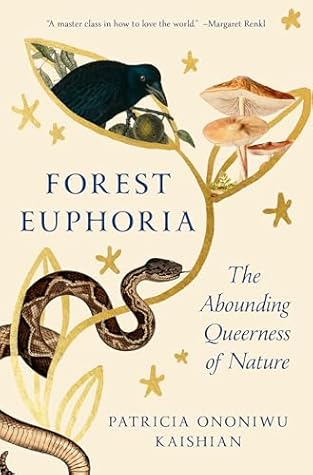More on this book
Community
Kindle Notes & Highlights
Read between
June 17 - June 18, 2025
I have built over time a deep kinship with species that have been maligned by other humans—venomous snakes, fungal parasites, soil-dwelling insects, slippery spineless beings—and the “undesirable” habitats they call home. Of these, snakes were my first love. Their habitats were also my refuge; their complication of category—somewhere between earthly and demonic—needed no explanation to me, a child who found herself within the dysphoric double consciousness of an amphibious personhood. Together we could slither between the rocky contours of the world, both natural and imposed, and rest in the
...more
I felt safest when I was unwitnessed by other people. I could move outside of society’s gaze, outside the grip of cultural prescriptions and interventions. My hair could run wild, I could dress androgynously, I could be covered in mud. Being in the culvert or the forest was a chance to move amphibiously, to shape-shift, to creep, to oscillate like algae in a riffle, to be neither a boy nor a girl and have no particular identity at all.
While many things about our human bodies and behaviors make us distinct from other species, it is unscientific hubris to build a hierarchy out of these traits. This hubris is what has thrust the planet and all its inhabitants into crisis.
I sometimes think about this at the scale of our bodies, mine and yours. We are more fluid and less predictable than we like to think about. Our tissues are full of species living cryptically in our folds. Not only do we share a common ancestor with the bacteria and fungi that inhabit us—as all life does—but our evolutionary journey cannot be disentangled from the needs and pressures of our microbial counterparts. Our bodies were not terra nullis, a blank slate taken over by microbes after natural selection sculpted us into our final form. There is no human species without accounting for a
...more
Evolutionary biologist J. B. S. Haldane famously (“famously” among entomologists, at least) said that if a creator had indeed designed all living organisms on earth, then that creator must have had an “inordinate fondness for beetles.”
After all, the word “symbiosis” was invented to describe lichens, the collaboration between fungi and algae, which foreground the interdependence of life on earth.
and some fungi, such as Schizophyllum commune, have as many as twenty-three thousand mating types.
Mycology as a discipline is itself full of queer investigators. Of respondents to the Mycological Society of America 2018 survey, 12 percent identified as LGBTQ, three to four times the national reported average in the same year, and the numbers have likely grown since then.
My philosophy of naming is this: though I acknowledge the determination and hard work of the taxonomic “forefathers,” I trace my scientific lineage to those who are less known or have been entirely forgotten. The quiet stewards, the painstaking naturalists, the community scientists. I draw inspiration from their patient, holistic, and arguably sacred art of observation.
But in the labouls I see what I love most about fungi—their unassuming ways of being, their queerness, their daring subversion of capitalist utility. Labouls are not going to save the world, nor should they have to. I love them anyway. I love their resplendence, only visible under the microscope, only when someone who loves them is looking carefully.
How cruel that women are pushed into relying on this nuanced and powerful skill for survival, then criticized for having developed it at all.
I looked around my small apartment, also full of bones, fungi, shells, flowers, feathers, and stones. Like the bowerbirds, I had carefully collected these things and arranged them with intention. Visitors often asked about the governing principles behind this assortment of stuff. All I could say was that, though I am clean and dislike clutter, I need my space to feel like a nest. I collect things that feel like gifts, imbued with a little extra magic. I study how they affect the energy of a space and I orient them accordingly. In all the moving and change I’ve experienced in my life, these
...more
We can’t help but wonder if the cicadas actually burrowed underground in 2004 to flee the presidency of George W. Bush. . . . We can only imagine what a difference the next 17 years of our movement will make to the lives of LGBTIQ people when the next generation of these cicadas emerges in 2038.
The influence of heteronormativity is evident in every step: the question asked, the investigative methods chosen, and the resulting panic when bias was not easily confirmed. How unscientific. Indeed, the eel question could just as well be called the human question. Our lack of imagination beyond boundaries and our violence extend to our own species as often as to the creatures we live beside.
“Everyone has odd little genetic variations, but intersex variations are stigmatized because they’re a threat to social structures dependent on binary sex models. Other people’s sociopolitical anxieties lead to damage being inflicted on our bodies and psyches.”
I love looking at all the muck, like a big and beautiful soup.
His neurodivergences and my ADHD behave like constructive interference—the phenomenon where two waves come together such that their oscillations are in the same direction and orientation, making their combined amplitude much larger than the peak of the individual waves on their own. Some people make you better.


